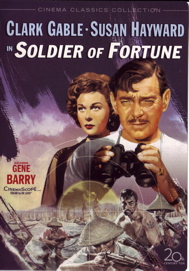Plot
Jane Hoyt arrives in Hong Kong, looking for her husband, reckless photojournalist Louis. He entered Communist China without a visa and was imprisoned as a suspected spy. She sees Hong Kong Marine Police Inspector Merryweather, who found Hoyt's cameras on the junk that took him into China. He can offer little help. During their conversation, he mentions American expatriate Hank Lee, a big name in smuggling and other shady activities.
She decides to arrange his escape, so she contacts Hank. He advises her to give up the foolhardy venture, but she refuses. She foolishly meets Fernand Rocha alone and gives him a $500 deposit to set up a rescue, but he merely gambles the money away and locks her up for his lecherous purposes. Word reaches Hank in time to save her.
Having fallen in love with Jane and realising that she will not let herself get involved with him while her husband's fate remains uncertain, Hank decides to rescue the man himself. Inspector Merryweather is inspecting Hank's boat when Hank decides to make his attempt, and is shanghaied into helping rescue the husband, who is being held in prison in Canton.
Louis is freed. Merryweather is forced to help Hank fight off a pursuing Chinese gunboat with a 20mm Oerlikon cannon concealed belowdecks. When they return safely to Hong Kong, Louis graciously bows out of his wife's life, allowing Hank and Jane to get together.
Production
The film was based on a novel by Ernest Gann published in October 1954. [4] Gann had lived in Hong Kong in his youth working for a telephone company and always wanted to write a book set there. He moved there in 1953, hired a Chinese junk and researched and wrote the novel. [5]
Gann's novel attracted the interest of film studios before it had been published. His novels Island in the Sky and The High and the Mighty had just been filmed with John Wayne and Wayne became interested in purchasing the film rights. [6] [7] However, film rights went to 20th Century Fox, who had a deal with Clark Gable, and Gable asked them to buy the novel as a vehicle for him. [8] Buddy Adler was assigned to produce, Edward Dmyrtryk to direct and Gann to write the script. [9]
Susan Hayward signed to play the female lead after Grace Kelly bowed out. Hayward, however, was in the middle of a divorce and could not take her children to Hong Kong with her. She offered to pull out of the film. Instead, she was allowed to remain in Hollywood and shoot all her scenes on the studio backlot. [10] To give the illusion of her presence in Hong Kong, a few brief outdoor scenes were shot at some of the city's landmarks, showing Gable together with a Hayward double whose back was to the camera. [11] In one instance of this, Gable and the Hayward double were shown entering the doorway of a building in Hong Kong. In the next scene, Gable and Hayward were shown walking onto a Hollywood set that was supposed to be the building's interior.
The opening and closing credit scenes of the film, featuring Gable looking out at the harbor skyline, were staged on the Peak Tram.
David Niven was going to play the police inspector, but then decided he did not want to go to Hong Kong, so the role was taken by Michael Rennie. [12]
The rest of the unit left for Hong Kong in November 1954 for five weeks of location filming. [13] [14] This was the first of four CinemaScope productions filmed by Adler's units in Asia in the mid-fifties.
This page is based on this
Wikipedia article Text is available under the
CC BY-SA 4.0 license; additional terms may apply.
Images, videos and audio are available under their respective licenses.
